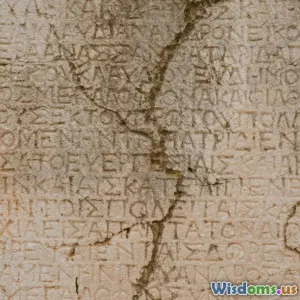
Understanding Ancient Civilizations Through Language
8 min read Explore how ancient languages unlock mysteries of early civilizations and reshape our understanding of human history. (0 Reviews)
Understanding Ancient Civilizations Through Language
Language is far more than just a medium of communication; it is a living archive of human thought, culture, and knowledge. As we explore ancient civilizations, language serves as our most powerful tool for unlocking the mysteries of the past — from their societal structures to their beliefs and innovations. In this article, we journey into how deciphering ancient scripts and languages has transformed archeology, history, and our understanding of humanity’s origins.
The Importance of Language in Understanding Ancient Societies
Language is often called the soul of a civilization. It encapsulates how people thought, what they valued, and how they interacted with their environment and each other. Unlike pottery or ruins, language conveys abstract concepts — religion, law, philosophy, and history — offering direct insight into a civilization’s identity and worldview.
Why Language Matters More Than Artifacts Alone
While artifacts show us how people lived, language reveals why. For example, deciphering the Code of Hammurabi informs us not only of Mesopotamian legal practices but also of their sense of justice, hierarchy, and governance. Written records allow historians to move beyond speculation to concrete knowledge and trace how ideas evolved over time.
Key Ancient Scripts and the Civilizations They Reveal
1. Cuneiform: The Dawn of Written Record
Cuneiform, developed by the Sumerians around 3200 BCE in Mesopotamia, is the oldest known writing system. Initially invented for accounting purposes, this wedge-shaped script evolved to record laws, literature, and history. The Epic of Gilgamesh, one of the world’s earliest literary masterpieces, was composed in cuneiform.
Deciphering cuneiform in the 19th century opened a window into the city-states of Sumer, Akkad, Babylon, and Assyria — revealing their complex bureaucracies, mythology, and innovations like early mathematics.
2. Egyptian Hieroglyphs: Symbols of Spiritual and Political Power
For centuries, Egyptian hieroglyphs remained a mystery. The Rosetta Stone’s discovery in 1799, containing the same text in Greek and Egyptian scripts, was pivotal in unlocking their meaning.
Hieroglyphs are more than just phonetic; they are symbolic, blending art with language. Their inscriptions tell tales of divine rulers, religious rituals, and ancient wisdom inscribed in temples and tombs. Decoding these symbols has vastly enhanced our understanding of ancient Egyptian religion, governance, and daily life.
3. The Indus Script: The Enigma of the Harappans
Despite numerous attempts, the Indus Valley script remains undeciphered. This is one of the biggest archaeological puzzles today. Its discovery on seals and pottery belonging to the Harappan Civilization (circa 3300–1300 BCE) hints at a sophisticated urban culture with trade networks extending from Mesopotamia to Central Asia.
Solving the Indus script puzzle could unlock vast knowledge about trade, social organization, and possibly early urban planning concepts.
4. Linear B: Revealing Mycenaean Greece
Discovered in the 20th century, Linear B was identified as an early form of Greek used by the Myceneans (circa 1450–1200 BCE). Decoding it proved that the Greeks’ written history extended much further back than previously thought. The tablets detail palace economies, religious practices, and feudal power structures.
It demonstrated how language can provide clarity on political systems and mythologies, as many Linear B tablets refer to gods and rituals referenced by later Greek classical texts.
The Linguistic Decipherment Process: Breakthroughs and Challenges
Decoding ancient scripts demands meticulous effort combining linguistic analysis, comparative studies, and often a key object, such as the Rosetta Stone. Scholars identify patterns, syntax, and vocabulary through bilingual texts or similar languages.
For example, Jean-François Champollion’s breakthrough in understanding Egyptian hieroglyphs relied heavily on comparing them to Coptic (the latest stage of ancient Egyptian language) and Demotic scripts.
Conversely, without bilingual clues, the Indus script remains elusive. Some suggest it might not represent a full language but specialized symbols or proto-writing.
Moreover, context is critical; archaeologists work closely with linguists to connect linguistic artifacts with historical settings.
Language as a Reflection of Cultural Identity and Exchange
Language preserves more than words; it encapsulates beliefs, values, and identity. Studying linguistic shifts or borrowing reveals contact between cultures. The spread of cuneiform to the Hittites or the adaptation of the Phoenician alphabet into Greek are prime examples.
Languages also encode worldviews; for instance, some Native American languages emphasize relationships between all living things, reflecting a philosophy directly visible through linguistic structure.
Thus, language can illuminate cultural exchanges, trade routes, migration patterns, and even conquest dynamics.
Modern Technology and Future Prospects
Cutting-edge technology like AI and machine learning now assists in pattern recognition and language reconstruction, speeding up decipherments and translation.
For example, computational linguistics is being used to analyze the Indus script and other undeciphered writings. Digitization of ancient texts also facilitates broader scholarly collaboration, increasing chances of breakthroughs.
Moreover, advancements in epigraphy (study of inscriptions) and 3D imaging allow never-before-seen visibility to worn or hidden texts on artifacts.
Conclusion: Language as the Key to Ancient Civilizations
In sum, language is an indispensable window into ancient civilizations, offering direct access to their minds, myths, and mundane details. From the first clay tablets to monumental inscriptions, languages recount humanity’s journey.
Deciphering ancient scripts transforms vague historical conjecture into rich stories of innovation, interaction, and culture. As technology and scholarship advance, we edge closer to unmasking remaining mysteries locked in ancient languages, deepening our appreciation of human history’s continuity and complexity.
By understanding ancient languages, we better grasp our shared heritage — a critical step toward comprehending ourselves in a global context.
“To have another language is to possess a second soul.” — Charlemagne
Whether through the melodic symbols of hieroglyphs or the elegant clay impressions of cuneiform, the languages of ancient civilizations persistently illuminate the human soul across millennia.
Rate the Post
User Reviews
Popular Posts





















